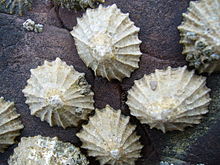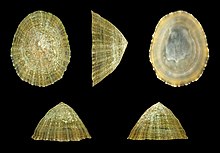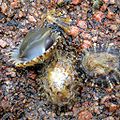Patella vulgata
| Patella vulgata | |
|---|---|

| |
| Live Patella vulgata on a rock in Wales | |

| |
| A Shell of Patella vulgata | |
| Scientific classification | |
| Kingdom: | |
| Phylum: | |
| Class: | |
| (unranked): | clade Patellogastropoda
|
| Family: | |
| Genus: | |
| Species: | P. vulgata
|
| Binomial name | |
| Patella vulgata Linnaeus, 1758
| |
| Synonyms[1] | |
| |
Patella vulgata, common name the common limpet or common European limpet[2] is an edible species of sea snail with gills, a typical true limpet, a marine gastropod mollusc in the family Patellidae.[1]
This species is found in the waters of western Europe.[3]
Radula
The radula in this species is longer than the shell itself. It contains 1,920 teeth in 160 rows of 12 teeth each. It is found attached to firm substrates from the high shore to the edge of the sublittoral zone, although it predominates in areas of wave action. Its shell is conical, up to around 6 cm long, and lacks defined chirality. Common limpets are believed to be able to live for up to twenty years.[4]
Patella vulgata has been the focus of a range of scientific investigation, as far back as 1935.[5] Its development is well described[6] and it has recently been the focus of transcriptomic investigation, providing a range of genomic sequence data in this species for analysis.[7]
Their teeth are the strongest natural material known. A study published in the Royal Society journal in 2015 concluded that "the tensile strength of limpet teeth can reach values significantly higher than spider silk, considered to be currently the strongest biological material, and only comparable to the strongest commercial carbon fibres.” The material was able to withstand 4.9 GPa. This considerable tensile strength of limpet teeth is attributed to a high mineral volume fraction of reinforcing goethite nanofibres.[8][9][10][11][12]
See also
Gallery
-
Four Patella vulgata limpets on a rock in northwestern Galicia. One turned over to show the underside and muscular foot
-
Shells of the common limpet from Wales
-
Patella vulgata in litoral of Finistère, near Porspoder - the region affected by the Amoco Cadiz tanker disaster in 1978
-
Drawing of the soft body and underside of the shell of Patella vulgata; a) foot b) fringed mantle c) tentacles d) mouth e) eyes f) gills
-
Radula of Patella vulgata; a) median teeth b) laterals c) uncini or marginals
-
Remains of a meal. Common limpet from Cantabrian Lower Magdalenian layer of the Altamira cave. - MHNT
-
Prepared as a dish known as lapas in Madeira.
References
- ^ a b Gofas, S. (2014). Patella vulgata Linnaeus, 1758. Accessed through: World Register of Marine Species at http://www.marinespecies.org/aphia.php?p=taxdetails&id=140685 on 2014-10-29
- ^ http://www.manandmollusc.net/molluscan_food_files/molluscan_food_6.html
- ^ Oliver, A.P.H. (2004). Guide to Seashells of the World. Buffalo: Firefly Books. 28.
- ^ "Limpets". BritishSeaFishing.co.uk. Retrieved 24 January 2014.
- ^ Smith, F (1935). "The Development of Patella vulgata". Philosophical Transactions of the Royal Society of London. Series B, Biological Sciences. 225 (520): 95–125. doi:10.1098/rstb.1935.0008.
- ^ Damen, Peter; Dictus, Wim J.A.G. "Cell Lineage of the Prototroch of Patella vulgata (Gastropoda, Mollusca)". Developmental Biology. 162 (2): 364–383. doi:10.1006/dbio.1994.1094.
- ^ Werner, Gijsbert D. A.; Gemmell, Patrick; Grosser, Stefanie; Hamer, Rebecca; Shimeld, Sebastian M. "Analysis of a deep transcriptome from the mantle tissue of Patella vulgata Linnaeus (Mollusca: Gastropoda: Patellidae) reveals candidate biomineralising genes". Marine Biotechnology. doi:10.1007/s10126-012-9481-0.
- ^ Asa H. Barber, Dun Lu, and Nicola M. Pugno (2015). Extreme strength observed in limpet teeth. Royal Society journal. doi:10.1098/rsif.2014.1326. Archived from the original on 19 February 2015.
{{cite book}}: Unknown parameter|deadurl=ignored (|url-status=suggested) (help)CS1 maint: multiple names: authors list (link) - ^ Webb, Jonathan. "Limpet teeth set new strength record" BBC News, 18 February 2015. Archive
- ^ NBC
- ^ BBC Video, explanation
- ^ BBC radio interview
- Linnaeus, C. (1758). Systema Naturae per regna tria naturae, secundum classes, ordines, genera, species, cum characteribus, differentiis, synonymis, locis. Editio decima, reformata. Laurentius Salvius: Holmiae. ii, 824 pp.
- Lespinet, Nederbragt, Cassan, Dictus, Van Loon, et al. Characterisation of two snail genes in the gastropod mollusc Patella vulgata. Implications for understanding the ancestral function of the snail-related genes in Bilateria. 2002.







